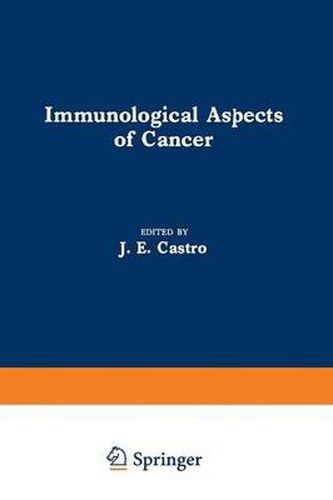Readings Newsletter
Become a Readings Member to make your shopping experience even easier.
Sign in or sign up for free!
You’re not far away from qualifying for FREE standard shipping within Australia
You’ve qualified for FREE standard shipping within Australia
The cart is loading…






This title is printed to order. This book may have been self-published. If so, we cannot guarantee the quality of the content. In the main most books will have gone through the editing process however some may not. We therefore suggest that you be aware of this before ordering this book. If in doubt check either the author or publisher’s details as we are unable to accept any returns unless they are faulty. Please contact us if you have any questions.
An immunological approach to the treatment of cancer has many theoretical features to commend it. There should be specificity, so that tumour cells alone are destroyed whilst normal tissues are unaffected. Provided the tumour is uni form and all of the cells have appropriate antigens, every malignant cell should be destroyed and even distant metastases dealt with. So far these speculative advantages are unfulfilled and the initial optimism that surrounded im munotherapy has not been sustained. Acceptance of the precepts of tumour im munology continues but these disappointing observations had led to increasing scrutiny of certain aspects. The purpose of this chapter is to review the prin ciples which underly tumour immunology and immunotherapy, so that the more detailed studies that follow can be considered in perspective. TUMOUR ANTIGENS (Chapter 2) For a tumour to initiate an immunological response, it must possess distinctive antigens. Much of the early work in tumour immunity was confused because it was not appreciated that tumours, like other tissues, exhibit transplan tation antigens. Only when syngeneic tumours are used can tumour antigens alone be studied and it was the introduction of inbred mouse strains which allowed Foley in 1953’ to produce the first evidence for specific an tigenicity of experimental tumours. Demonstration of these antigens requires that pretreatment with syngeneic tumour will influence the growth of a sub sequent challenge with the same neoplastic cells.
$9.00 standard shipping within Australia
FREE standard shipping within Australia for orders over $100.00
Express & International shipping calculated at checkout
This title is printed to order. This book may have been self-published. If so, we cannot guarantee the quality of the content. In the main most books will have gone through the editing process however some may not. We therefore suggest that you be aware of this before ordering this book. If in doubt check either the author or publisher’s details as we are unable to accept any returns unless they are faulty. Please contact us if you have any questions.
An immunological approach to the treatment of cancer has many theoretical features to commend it. There should be specificity, so that tumour cells alone are destroyed whilst normal tissues are unaffected. Provided the tumour is uni form and all of the cells have appropriate antigens, every malignant cell should be destroyed and even distant metastases dealt with. So far these speculative advantages are unfulfilled and the initial optimism that surrounded im munotherapy has not been sustained. Acceptance of the precepts of tumour im munology continues but these disappointing observations had led to increasing scrutiny of certain aspects. The purpose of this chapter is to review the prin ciples which underly tumour immunology and immunotherapy, so that the more detailed studies that follow can be considered in perspective. TUMOUR ANTIGENS (Chapter 2) For a tumour to initiate an immunological response, it must possess distinctive antigens. Much of the early work in tumour immunity was confused because it was not appreciated that tumours, like other tissues, exhibit transplan tation antigens. Only when syngeneic tumours are used can tumour antigens alone be studied and it was the introduction of inbred mouse strains which allowed Foley in 1953’ to produce the first evidence for specific an tigenicity of experimental tumours. Demonstration of these antigens requires that pretreatment with syngeneic tumour will influence the growth of a sub sequent challenge with the same neoplastic cells.